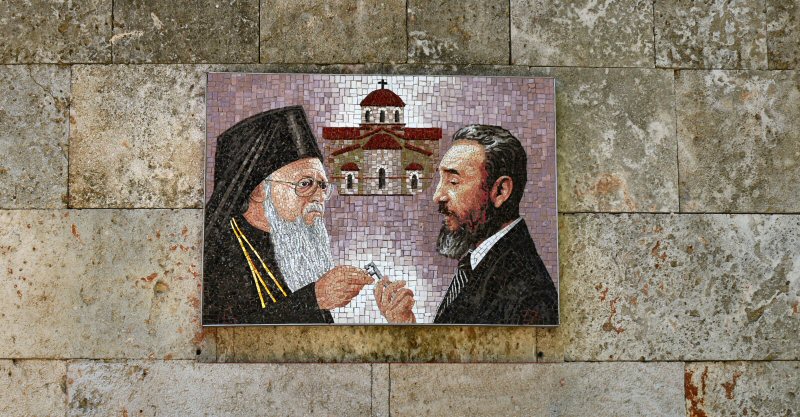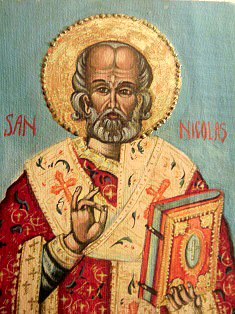
THE ORTHODOX COMMUNITY IN CUBA
At the beginning of the 20th
century, the number of the people that arrived in Cuba
through the merchant fleets from Russia, Greece, Lebanon,
Syria and some other Slavic countries and remained living on
the island, increased to such a degree that it became
possible to talk about an Orthodox community. These
immigrants wanted to build their church where they would
marry and baptize their children. For some it was also a
space of spiritual refuge. Thus, the first orthodox church,
the Templo de los Santos Constantino y Elena, was built in
an area close to the cemetery of Colón in 1940s.
The Greek priests were attending in
the church, and the congregation consisted of more than one
hundred people. During the same period other Orthodox
temples were erected in different parts of the country,
especially in the East. After the revolution these people
could not return to the island due to several reasons and
the few who remained on the island decided to leave also.
Thus, the temple passed into oblivion and totally abandoned
in the early 1970s. In the meantime, the Orthodox Christian
Association of Cuba that was recognized legally in 1964,
dissolved itself in 1978. The religious services were
carried out in chapels lent by the Catholic Church and other
Christian denominations.
In 1997, Archbishop Atenágoras,
leader of the Orthodox Archbishop of Central America and the
Caribbean, visited Cuba and held talks with the government.
Finally, in 2004, a temple in Byzantine style, the Sacred
Orthodox Cathedral of San Nicolás de Myra, was inaugurated
in the back garden of the Iglesia y Convento de San
Francisco de Asís and consecrated by the Ecumenical
Patriarch Bartholomew in a ceremony, attended by
Fidel Castro. The same year the first stone of the new
Russian Orthodox temple was laid by the Patriarch Kirill,
XVI. patriarch of Moscow and head of the Russian Orthodox
Church, and when the new temple was inaugurated four years
later in 2008, he officiated the Divine Liturgy during the
consecration ceremony of the Russian Orthodox cathedral, the
Catedral Ortodoxa de Nuestra Señora de Kazán. At present the
Orthodox community is composed of about 3.500 faithfulls,
one third of it being Cubans. Except Havana, there are also
Orthodox communities in Holguin, Pinar del Rio and Ranchuelo.
The construction of the
Sacra Catedral Ortodoxa Griega San
Nicolás de Mira began in 2001. After the consecration by I. Bartholomeos (Bartholomew), the current Archbishop of
Istanbul and the Ecumenical Patriarch, it was inaugurated in
2004. Fidel Castro Ruz attended the ceremony and deposited a
bouquet of flowers next to the statue of Mother Teresa de
Calcuta that precedes the passage through the homonymous
garden to the temple.
THE CHURCH
The exceptional small Greek Orthodox
church was built in a classic Byzantine style, with a
cross-shaped plan and vaulted roofs with the dome in the
center. The construction was a challenging work, as some old
construction techniques had to be carried out, like the
erection of the barrel vaults. The walls are made of
limestone and the building is covered with red tiles
uniformly. The semi-circular pediment over the entrance
encloses a Romanesque tympanum, brought from a demolished
Spanish church of the 15th century. In that relief Jesus
appears surrounded by angels and apostles.
In contrast to the austere image of
the exterior, the interior decoration is splendid, like in
all Byzantine churches. Many examples of art of iconostasis
that is the main and most distinctive feature of all
Byzantine churches, are adorning the interior walls. The
intricate carved woodwork and the impressive chandelier are
outstanding.
There are some stone tablets, hung
on a wall on the passage to the church. These stone tablets
contain some symbolic pieces from various Orthodox churches
in the world, such as the Balıklı Virgin Mary Greek Orthodox
Monastery (Istanbul, Turkey), Vatopedi Monastery (Athos
Mountain, Greece), Monastery of Varlaam (Kalambaka, Greece),
Monastery of Arcade (Island of Crete,
Greece), Apokalipsis Cave (Patmos Island,
Greece), Sanctuary of San Juan El Ruso (Euboean Island,
Greece).

The Sacra Catedral Ortodoxa
Griega San Nicolás de Mira is located at the end of the
Jardín Madre Teresa de Calcutta that occupies the backside of
the Basilica Menor de San Francisco de Asís.

 San Nicolás de Mira (Saint Nicholas
of Myra) (270-343), also known as Nicholas of Bari, was an
early Christian bishop of the ancient Lycian city of Myra in
Asia Minor (today Demre district in Anatolia of Turkey)
during the time of Roman Empire.
Because of the many miracles attributed to his intercession,
he is also known as Nicholas the Wonderworker.
His legendary habit of secret gift-giving to the children
was interlinked with the miracle of Santa Claus.
After his death he was canonized as a saint of the
Byzantine Orthodox Church, and in 4th century a church was
built in Myra to pay tribute to his altruistic contribution
to children and to people that experience difficulties. He
is the Patron Saint of many cities in Europe, such as
Naples, Bari, Sicily, Freiburg, even New York, as well as
sailors, merchants, archers,
repentant thieves, children and students.
San Nicolás de Mira (Saint Nicholas
of Myra) (270-343), also known as Nicholas of Bari, was an
early Christian bishop of the ancient Lycian city of Myra in
Asia Minor (today Demre district in Anatolia of Turkey)
during the time of Roman Empire.
Because of the many miracles attributed to his intercession,
he is also known as Nicholas the Wonderworker.
His legendary habit of secret gift-giving to the children
was interlinked with the miracle of Santa Claus.
After his death he was canonized as a saint of the
Byzantine Orthodox Church, and in 4th century a church was
built in Myra to pay tribute to his altruistic contribution
to children and to people that experience difficulties. He
is the Patron Saint of many cities in Europe, such as
Naples, Bari, Sicily, Freiburg, even New York, as well as
sailors, merchants, archers,
repentant thieves, children and students.
